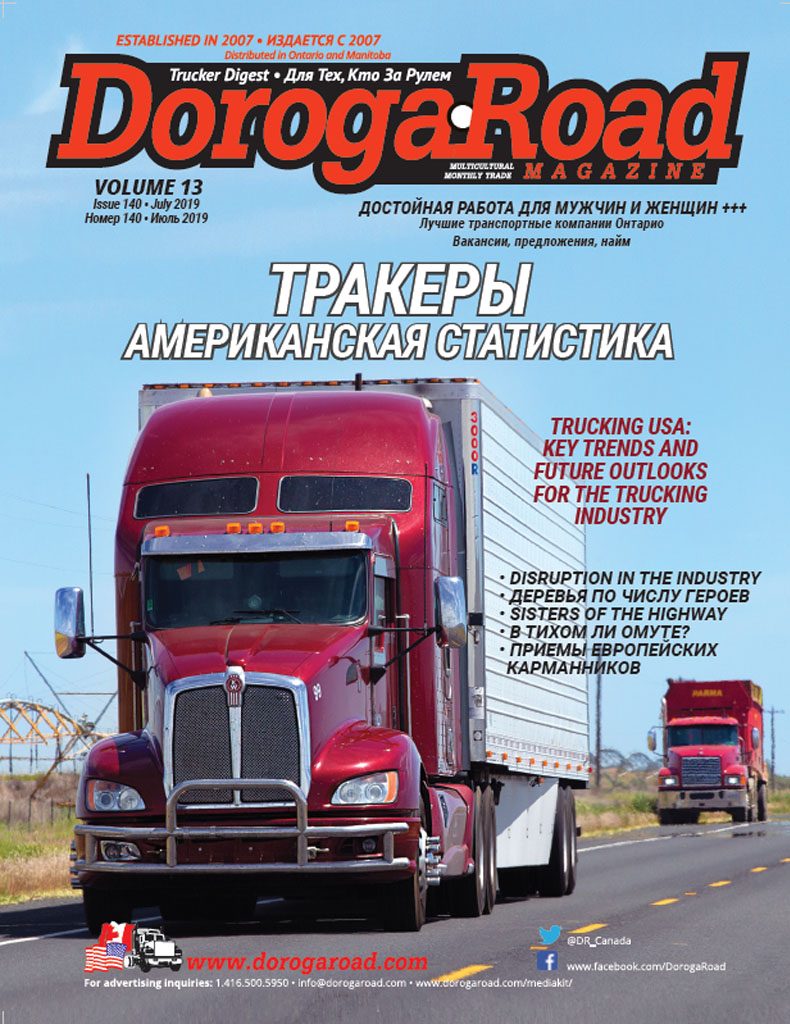As e-commerce continues to grow, the demand for trucks continues to rise alongside it
From coast to coast, across mountain ranges, and through the extensive North American highway system, the trucking industry keeps our modern society well-stocked with a dynamic inventory of products and goods. Dubbed the “lifeblood of our economy” by President Donald Trump, not only does this industry facilitate the nationwide distribution of food, clothes, medicine, and other consumer products, it also supports a substantial portion of America’s revenue and workforce.
There are two main types of trucking companies: full truckload (FTL) and less than truckload (LTL) carriers. FTL carriers typically deliver large deliveries to a single recipient, while LTL freight carriers deliver smaller parcels and shipments to several recipients.
Fast Facts About the U.S. Trucking Industry
According to a 2018 report from the American Trucking Association, 10.77 billion tons of freight was moved across the country by trucks last year.
In 2017, the trucking industry generated more than $700 billion in revenue.
In 2015, registered trucks in the U.S. traveled a total of 450.4 billion miles.
FTL Trucking Industry Overview
Full truckload shipping is generally responsible for moving large amounts of cargo. These trucks typically haul deliveries of up to 50,000 pounds. According to Plunkett Research, an industry analytical research company, the FTL sector currently generates more than $116 billion in revenue and is projected to reach more than $167 billion by 2025. Although 90% of FTL fleets have fewer than six trucks, some companies, such as Knight-Swift Transportation and J.B. Hunt, are quite large.
FTL Trucking Company Spotlight: Knight-Swift Transportation
In September 2017, Swift Transportation and Knight Transportation, two U.S. truckload carriers based out of Phoenix, Arizona, merged their companies into one massive organization called Knight-Swift, becoming the largest trucking company in the United States.
As of December 2017, Knight-Swift boasted a fleet of:
- 18,381 company tractors
- 4,688 independent contractor tractors
- 74,949 trailers
- 9,122 intermodal containers
Together, these 107,140 units covered almost 1 billion miles in 2017 and generated more than $1.4 billion in revenue. The company’s earnings broke down as follows:
Knight-Trucking - $906.48 million
Knight-Logistics - $234.16 million
Swift-Truckload - $609.11 million
Swift-Dedicated - $200.63 million
Swift-Refrigerated - $254.1 million
Swift-Intermodal - $130.44 million
While Knight’s trucking fleet earns the most revenue overall, in terms of average revenue per tractor, Swift’s truckloads and refrigerated carriers have the most value. On average, Swift truckload tractors earn $196,860 each, while refrigerated carriers earn $194,930 each. By comparison, Knight’s truck carriers earn $174,550. Knight logistic and Swift intermodal tractors generate the least revenue, earning only $1,360 and $1,880, respectively, on average per tractor.
FTL Trucking Company Spotlight: J.B. Hunt Trucking
As one of the largest trucking and logistics companies in the U.S., J.B. Hunt’s reach stretches across all of North America. The company’s business is split into four distinct segments: Intermodal (JBI), Dedicated Contract Services® (DCS), Integrated Capacity Solutions (ICS), and Truckload (JBT).
Between JBI, DCS, and JBT, J.B. Hunt operated more than 126,000 pieces of trucking equipment in 2018, most of which are company owned. All four segments combined carried approximately 6,620,000 loads in 2018, generating almost $8.6 billion, broken down as follows:
JBI - $4.72 billion; DCS - $2.16 billion; ICS - $1.3 billion; JBT - $417 million
LTL Trucking Industry Overview
LTL trucking carriers specialize in handling cargo items that are larger than a typical package, but smaller than a full-trailer size. Their shipments tend to weigh less than 10,000 pounds. According to Plunkett Research, the LTL trucking sector currently generates more than $48 billion, and is expected to reach almost $69 billion by 2025. Big players in the LTL trucking game include companies like FedEx, YRC Worldwide, and Old Dominion Freight Line.
LTL Trucking Company Spotlight: FedEx Freight
Well-known among businesses and consumers alike, FedEx Freight offers LTL trucking services for any route length throughout the U.S., including Alaska and Hawaii. According to the company’s most recent financial reports:
- FedEx Freight is equipped with an estimated 90,000 operational vehicles, 670 aircraft, and 100,000 drop-off locations.
- FedEx also provides freight services to more than 220 countries and territories.
- This segment of the company generated more than $6.18 billion in 2018.
- The $6.18 billion was a 12% increase from 2017.
- On average, the company handled 74,500 priority and 31,900 economy shipments on a daily basis.
- More than 92% of the company’s revenue is spent on operating expenses.
- As of May 2018, FedEx Express reported that it employed an estimated 166,000 permanent full-time employees, as well as approximately 61,000 permanent part-time employees.
LTL Trucking Company Spotlight: YRC Freight
Servicing a wide range of industries within the commercial, industrial, government, and retail sectors, the freight segment of holding company YRC Worldwide provides delivery services for various product categories, including clothing, automotive parts, food, furniture, textiles, wood products, machinery, and petroleum products.
While the company also offers some FTL services, the bulk of its business stems from LTL shipping. According to YRC Freight’s most recent financial reports:
- YRC employs approximately 19,000 employees.
- The company’s annual 10.5 million shipments weigh about 1,200 pounds on average.
- These shipments, on average, travel about 1,300 miles.
- The company’s fleet consists of an estimated 7,600 tractors and 30,900 trailers, which include both owned and leased vehicles.
- The YRC Freight network consists of 260 service facilities located throughout North America.
- In 2017, the company generated operating revenue of almost $3.07 billion.
LTL Trucking Company Spotlight: Old Dominion Freight Line
Unlike the other two highlighted LTL trucking companies, both of which have other business segments in addition to their LTL freight services, Old Dominion Freight Line is exclusively dedicated to LTL trucking services. According to the company’s most recent financial reports:
As of December 2018, Old Dominion operated a total of 235 service center locations.
The company’s fleet consisted of 9,254 tractor units with an average age of 3.5 years, 24,685-line haul trailers with an average age of 6.8 years, and 11,044 P&D trailers with an average age of 7.4 years.
Old Dominion employs more than 21,000 employees, including more than 11,000 drivers.
In 2018, the company generated more than $4.04 billion in operational revenue.
The U.S. Truck Driver Shortage
In order to maintain its strength as an economic stronghold, the trucking industry as a whole will have to address certain issues, including the pervasive truck driver shortage.
Fast Facts About Truck Driving Careers
The trucking industry today employs 7.7 million people, which includes 3.5 million drivers.
Currently, it’s estimated that only 200,000 drivers are women, which accounts for only 5.8% of drivers.
The number of trucking jobs is expected to grow by 6% by 2026.
About 1.7 million truck drivers are heavy and tractor-trailer drivers.
Approximately 40.6% of drivers are minorities.
As of May 2017, the median pay for heavy and tractor-trailer drivers was $42,480 per year.
In 2019, truck driver wages are expected to rise by up to 10%.
Truck drivers can work up to 65 hours a week.
The Truck Driver Lifestyle: Voices from the Road
In May 2018, the Washington Post wrote an article exploring the various factors behind the truck driver shortage. The article featured interviews with both fledgling and seasoned drivers, revealing a kaleidoscope of voices, each one articulating problems that reached far beyond wages.
One recurring theme, which came up often among the drivers interviewed, was the truck driving lifestyle itself. Between demanding hours, isolation, and irregular opportunities for self-care, the truck driving lifestyle can be very difficult, and this is cited by some as a contributing factor in the industry shortage.
Trucking Life and Family
When asked if he would recommend the truck driving profession to others, Michael Dow, co-founder of Dow Brothers Transportation in Dallas, Texas, told the Washington Post, “I don't recommend it to anyone who has a family. My kids are in their 20s now. I missed most of their lives growing up. They tell me they wish I would have been home more. I have been divorced two times because of truck driving. For a real perspective, talk to a trucker’s wife.”
Truck Driver Health and Wellness
Donna Penland, a long-haul driver from Houston, Texas, echoed this sentiment: “It takes a special kind of person, because you basically give up your life for the job. You are dedicated to that truck. … I gained 60 pounds because it’s a sedentary life. You just drive, sleep, drive, sleep. Companies don’t treat you like a human. You are just a machine that makes money for them.”
Challenges for Female Truck Drivers
Penland also added that, as a female truck driver, there are additional obstacles to overcome. “I think it is a good profession for women, but there are a lot of doors to break down,” she told the Washington Post. "The guys treat you like you’re stupid and don’t know anything.”
Increased Truck Driver Regulations
For some truckers, such as Lee Klass of Portland, Oregon, an experienced driver of 40 years, the long hours and unusual lifestyle aren’t necessarily the biggest issues with the trucking industry. “It’s a tough life, and there are too many regulations now. There’s a ton more electronic monitoring than when I started,” he told the Washington Post.
For drivers like Klass, who value autonomy, self-employment, and limited supervision, this increased level of monitoring is problematic. “As long as you got your loads delivered, nobody bothered you,” Klass recalls of those earlier years. “Now you’re monitored. As soon as you stop, you get a message from the company asking, ‘Why have you stopped?’ And the government is tracking you with the electronic logging device.”
Uplifting the Trucking Industry
While wages and long hours certainly play a role in the declining number of truck drivers, the issue seems to stem mainly from more nuanced factors, such as the lifestyle involved, interpersonal struggles, and the increasing use and standardization of disruptive technologies.
In order to remedy the shortage, many companies are taking a proactive approach to overhaul the public’s perception of the trucking industry. For example, some companies are focused on expanding truck driver diversity; by actively welcoming women and minorities into the industry, companies will not only have more candidates to choose from, but will also help in changing the pervasive “trucker image” discussed above.
And while the nature of the job will likely always require long, unpredictable hours, having flexible shift options may help make the job less demanding, making it more attractive to would-be drivers.
Disruptive Technology and the Trucking Industry
As for disruptive technologies, many industry experts predict that companies will be making increasing use of data technologies, electric trucking vehicles, and automated trucking. Although some of these technologies are still far from seeing full implementation on a large scale, it’s only a matter of time before they become more widespread — or even standard for the industry.
Not all existing drivers will be comfortable with this, and it may be difficult to retain them. Companies are urged to keep the lines of communication open with their drivers and help ease the transition to more tech-heavy processes if and when it occurs.
Trucking Industry Outlook
Although some economic experts predict that 2019 will see a decrease in general economic growth — and, by extension, a dip in the growth of the trucking industry — the sector still serves as a big source of revenue in the U.S. Furthermore, as e-commerce continues to grow, the demand for trucks continues to rise alongside it, although this will probably prove to be more of a boon to LTL trucking companies than any others.








 Magazine about
Magazine about